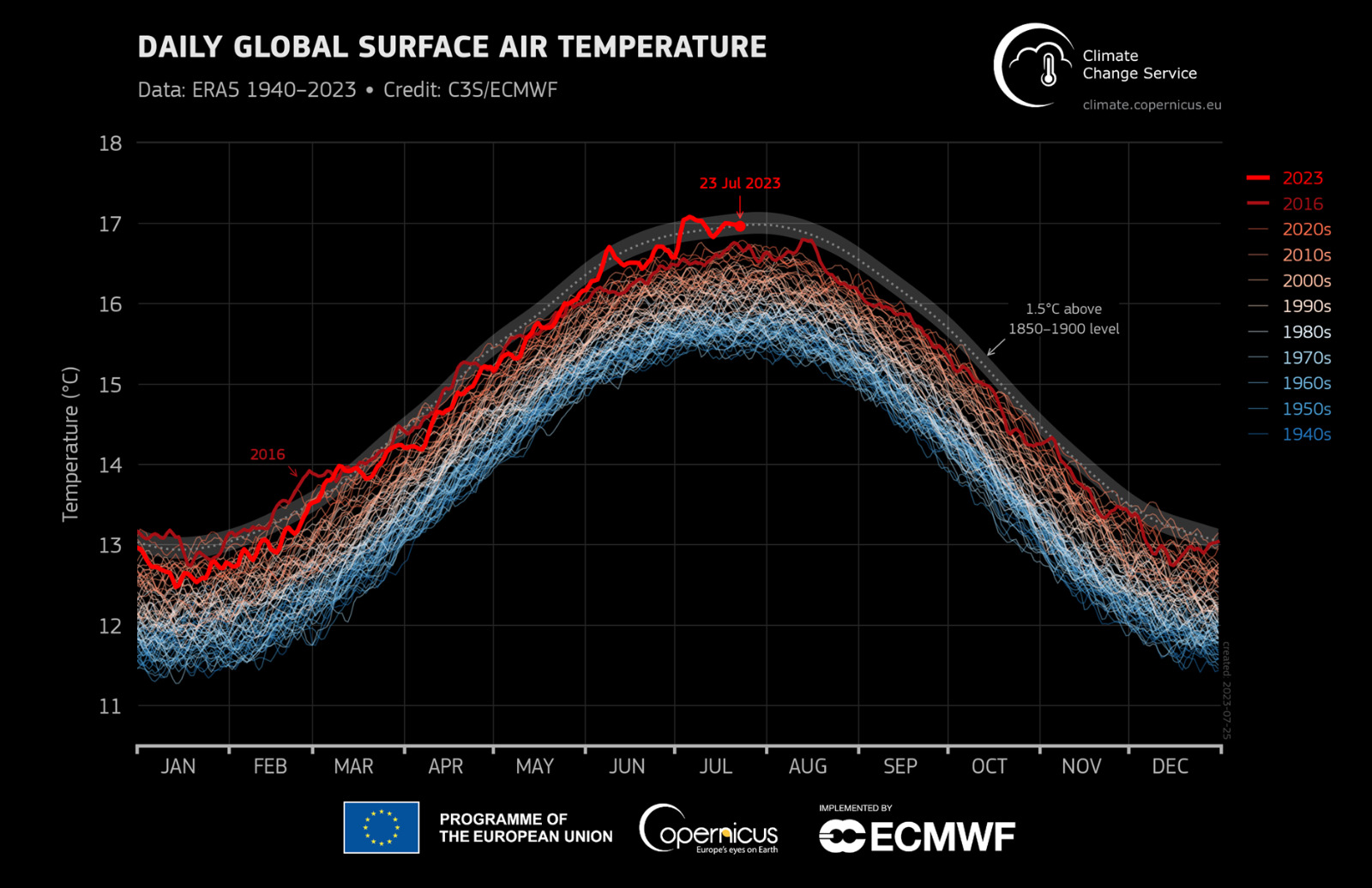Global temperature records in July are due to climate change

According to ERA5 data from the EU-funded Copernicus Climate Change Service (C3S), the first three weeks of July were the warmest three weeks on record, and the month is on track to be the warmest July and the warmest month on record. These temperatures were associated with heatwaves across much of North America, Asia and Europe, which, along with wildfires in countries such as Canada and Greece, had a significant impact on human health, the environment and the economy.
" We don't have to wait for the end of the month to know that. If there is not a mini ice age in the next few days, July 2023 will break all records," said the Secretary-General of the United Nations, António Guterres, who now expects the international community to take rapid and radical countermeasures because:
"The era of global warming is over. The era of global cooking has begun."
1.5° Celsius exceeded
The global average temperature temporarily exceeded the threshold of 1.5° Celsius above pre-industrial levels in the first and third week of the month. This 1.5° Celsius marks the target that the global community set itself in Paris in 2015 (Paris Agreement). We have exceeded this mark much sooner than we thought.
" For large parts of North America, Asia, Africa and Europe, it is a cruel summer. For the entire planet, it is a catastrophe. And for the scientists, it is clear: humans are to blame. All this is in line with predictions and repeated warnings. The only surprise is the speed of change."
Antonio Guterres
Carlo Buontempo, Director of the Copernicus Climate Change Service (C3S) at ECMWF, comments: "The record temperatures are part of the trend towards a drastic rise in global temperatures. Anthropogenic emissions are ultimately the main cause of this temperature rise." He added: "It is unlikely that the July record will remain a one-off this year."
Air temperatures
2023 will most likely be the warmest July and also the warmest month since records began, after June was already the warmest. The global mean surface air temperature reached its highest daily value of 17.08 degrees on July 6, closely followed by July 5 and 7. The previous record was set on August 13, 2016 with a value of 16.8 degrees. This record was exceeded on almost every day in July this year.
Sea surface temperatures
Since May, the global average sea surface temperature* has been well above the values previously observed for this time of year, contributing to the exceptionally warm July.
Daily sea surface temperatures (SST), averaged over the global extrapolar oceans (60°S-60°N), have remained at record levels for the time of year since April 2023. In particular, since around mid-May, global SST values have risen to unprecedented levels for the time of year. According to the ERA5 data, the daily SST value reached 20.94 °C on July 19, only 0.01 °C below the highest value measured on March 29, 2016 (20.95 °C).
Temperature records
The national meteorological and hydrological services have reported a series of daily and stationary temperature records and are responsible for checking new national temperature records. China, for example, set a new national temperature record of 52.2 °C on July 16 (Turpan city in the Chinese province of Xinjiang), according to the Chinese Meteorological Administration.
In Phoenix in the US state of Arizona, temperatures rose to over 43 degrees for three weeks in a row - a record. And in Death Valley, California, temperatures of more than 50 degrees Celsius were recorded.
In Europe, the hottest day ever was recorded in Catalonia and the highest daily minimum temperatures ever were reached in other parts of Spain. The temperature record for continental Europe of 48.8 °C measured in Sicily on August 11, 2021 was not broken during the heatwave in July, according to preliminary data.
Heat deaths
According to a press release from the World Weather Attribution (WWA ) research network, dozens of people have died as a result of the heat in the United States. Several heat-related deaths have been confirmed in the US, including migrants at the US-Mexico border. In Mexico alone, over 200 people have died as a result of the heat. Spain, Italy, Greece, Cyprus, Algeria and China also reported heat-related deaths and a sharp rise in hospital admissions due to heat-related illnesses.
Heat warnings are in place for large parts of the population in Italy and Spain and for over 100 million people in the south of the USA. Demand for electricity rose sharply in all three regions, which had a negative impact on a number of important crops, including olive oil in Spain and cotton in China.
"A taste of the future"
"The extreme weather that affected many millions of people in July is unfortunately the harsh reality of climate change and a foretaste of things to come," said the Secretary General of the World Meteorological Organization, Prof. Petteri Taalas. And further:
"The need to reduce greenhouse gas emissions is more urgent than ever. Climate action is not a luxury, it's a must."
This trend could worsen in the future, according to scientist Friederike Otto from Imperial College London and her WWA team. "As long as we keep burning fossil fuels, we will see more and more of these extremes," she continued.
Heatwaves impossible without climate change
One of the findings of a new rapid analysis by the WWA is that without human-induced climate change, this year's heat events would have been extremely rare. In China, such an event would occur about once every 250 years, while maximum heat like that in July 2023 in the USA/Mexico region and in southern Europe would have been virtually impossible if humans had not warmed the planet by burning fossil fuels.







